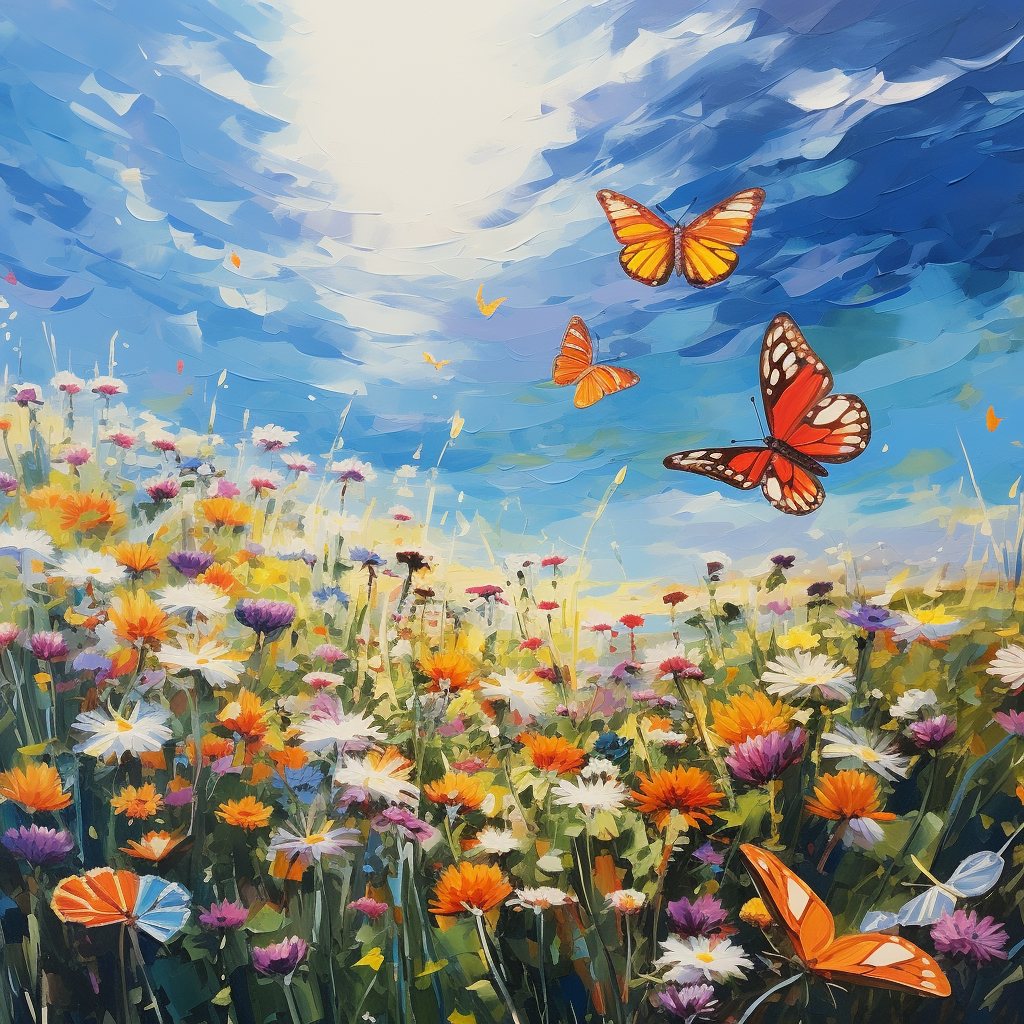Butterflies! They enchant us with their vibrant colors and fluttering wings. They also symbolize transformation. But have you wondered, how long do butterflies live?
The butterfly lifespan varies. Some last a few days, others a few months. For instance, monarch butterflies live two to six weeks. The brimstone butterfly? It can live nine months! Generally, bigger butterflies outlive smaller ones.
Many factors influence a butterfly’s life. The climate, their home, their food. Warm climate butterflies usually live shorter lives than cool climate ones. If a butterfly’s home lacks resources, it probably won’t live as long as one with plenty. Knowing butterfly lifespan helps conservationists and researchers protect these beauties and their homes.
Contents
- 1 Stages in a Butterfly’s Life
- 2 Butterfly Life: What Counts?
- 3 Wild vs Captive Butterfly Lifespan
- 4 Life of Various Butterflies
- 5 Brief Lives of Butterflies
- 6 Your Takeaway
- 7 Common Questions
- 7.1 How long does a butterfly typically live?
- 7.2 Which butterfly species has the longest lifespan?
- 7.3 What factors affect the lifespan of a butterfly?
- 7.4 Do butterflies live longer in captivity or in the wild?
- 7.5 How long do Painted Lady butterflies typically live?
- 7.6 Do all butterfly species have similar lifespans?
Stages in a Butterfly’s Life
The butterfly life cycle is fascinating. It has four parts: egg, larva, pupa, and adult. Every stage is important and unique to the butterfly’s growth.
Egg Stage
The butterfly life cycle begins when a female butterfly lays her eggs on a host plant. The eggs are usually laid in clusters and are attached to the leaves or stems of the plant. The eggs are small and round, and they may be white, yellow, or green, depending on the species.
Larva Stage
After a few days, the eggs hatch into caterpillars, which are also known as larvae. The larvae are voracious eaters and spend most of their time eating leaves. As they grow, they shed their skin several times, and their body shape changes. The larvae are often brightly coloured and have distinctive markings that help to protect them from predators.
Pupa Stage
When the larvae have reached their full size, they enter the pupa stage. During this stage, the caterpillar spins a silk cocoon around itself, or it may attach itself to a leaf or stem and shed its skin to reveal a hard, protective case called a chrysalis. Inside the cocoon or chrysalis, the caterpillar undergoes metamorphosis, transforming into an adult butterfly.
Adult Stage
After a few weeks, the adult butterfly emerges from the cocoon or chrysalis. The butterfly’s wings are wet and crumpled at first, but they quickly expand and harden. The adult butterfly feeds on nectar from flowers and mates to lay eggs and continue the life cycle.
Overall, the life cycle of a butterfly can take anywhere from a few weeks to several months, depending on the species and environmental conditions. It is a remarkable process that demonstrates the beauty and complexity of nature.
Butterfly Life: What Counts?
Ever wondered about a butterfly’s life span? Different factors decide how long these winged beauties remain with us.
Type
Different butterfly types have different lifespans. Larger ones usually outlive the smaller ones. Monarch butterflies, for instance, can flutter around for nine months; Painted Lady butterflies, though, stick around for just two weeks.
Place
Where a butterfly lives also matters. More sunlight, more life. Butterflies in warmer spots live longer. Plus, if they’re safe from threats and have food aplenty, they can expect a longer life.
Food
What a butterfly eats affects their age. Well-fed butterflies from nectar-rich flowers enjoy longer lives. Some species need certain plants to have babies. If those plants aren’t there, their life might get short.
To sum up, butterfly lifetimes rely on type, place, and food. Acknowledging these can deepen our appreciation of these nature’s wonders and the fine ecological balance they represent.
Wild vs Captive Butterfly Lifespan
Butterflies, known for their fragile beauty, have short lives. They live longer in captivity than in the wild.
In the wild, butterflies face tough conditions. Predators, diseases, and weather pose risks. Habitat loss is also a threat. Wild butterflies live about 2-4 weeks on average. Some types, however, can survive up to 6 months.
Butterflies in captivity live longer due to a controlled environment. They’re safe from predators and diseases. Their food and habitats are well-managed. Captive butterflies average 1-2 months of life. But, some species endure for a year.
However, life in captivity may not be high-quality for butterflies. They might lack exercise and social contact experienced in the wild. Also, captive breeding can lead to genetic issues and less genetic diversity.
In conclusion, a butterfly’s lifespan depends on environment and species. While captivity offers a longer life, it may lower quality of life. This trade-off needs consideration.
Life of Various Butterflies
Butterflies typically have brief lives, only weeks or months. But some butterflies break this trend! Here are some butterflies that live the longest:
1. Monarch Butterfly
The Monarch Butterfly is famous. They migrate long distances, from Canada to Mexico, a journey that can take three generations. They can live up to 9 months, much longer than most butterflies.
2. Mourning Cloak Butterfly
The Mourning Cloak Butterfly is big and found everywhere in the Northern Hemisphere. Their dark brown wings have yellow edges. They can live up to 11 months, one of the longest spans for butterflies.
3. Question Mark Butterfly
The Question Mark Butterfly is a medium-sized North American butterfly. They are unique because they have marks like question marks. They live longer than most butterflies, up to 10 months.
4. Peacock Butterfly
The Peacock Butterfly is large, colorful, and found in Europe and Asia. Their wings have unusual eye-like designs. They can live up to 11 months, one of the butterfly world’s longest lives.
Certain butterfly breeds can live up to one year, though most live less. The monarch, mourning cloak, question mark, and peacock butterflies are a few species with long lifespans.
Brief Lives of Butterflies
A number of butterfly types only live for a handful of days or weeks. The shortest living butterflies include:
1. Mayflies
Mayflies look like butterflies but technically, they aren’t. Their lifespan is extremely brief, with some lasting mere hours. Their life mainly revolves around aquatic nymph states. The adult phase, spent mating and laying eggs, is fleeting.
2. Small Coppers
Small Coppers, found in Europe and Asia, have a 25-30mm wingspan and live a few short weeks. They’re often spotted in grassy meadows. Their larvae thrive on sorrel and dock plants.
3. Common Blues
Common Blues, petite butterflies found in Europe, Asia, and North Africa, boast a 25-35mm wingspan and live a few weeks. Commonly seen in meadows, their larvae eat clover and other legumes.
4. Small Tortoiseshells
The Small Tortoiseshell, a European and Asian species, has a 45-55mm wingspan and lives several weeks. You can frequently sight them in gardens and meadows. Their larvae enjoy nettles.
Orange Tips: A Snapshot
Orange Tips, butterflies found in Europe and Asia, have a tiny 45mm wingspan. Their lives span a few weeks tops. Look for them in meadows and woods — they prefer Dining on mustard family plants.
They live short lives, but oh, they’re essential! They pollinate and give other animals food.
Your Takeaway
Do all butterflies have short lives like Orange Tips? Not really! Lifespans vary wildly per species. Some last a few days, others stick around for months or even a year. Environment, predators, and genes shape these lifespans.
Remember, butterflies’ lives may be brief, but they’re critical pollinators and ecosystem parts. Plus, their beauty captivates people globally.
Knowing about butterfly lifespans and the impacting factors allow conservationists and researchers to safeguard these essential insects for future generations’ delight.
Common Questions
How long does a butterfly typically live?
Butterfly lifespans? They’re all over the map! Some species last just a few days, others up to a year. A month is about the average for most.
Which butterfly species has the longest lifespan?
The butterfly species with the longest lifespan is the Brimstone butterfly. This species can live up to 12 months.
What factors affect the lifespan of a butterfly?
Several factors can affect the lifespan of a butterfly, including environmental conditions, food availability, and predators. Some species may also have genetic factors that influence their lifespan.
Do butterflies live longer in captivity or in the wild?
Butterflies generally live longer in captivity than in the wild. This is because they are protected from predators and have a constant supply of food and water.
How long do Painted Lady butterflies typically live?
Painted Lady butterflies typically live for about two weeks.
Do all butterfly species have similar lifespans?
No, butterfly species have varying lifespans. Some species only live for a few days, while others can live for several months. The lifespan of a butterfly is largely determined by its species and environmental conditions.












